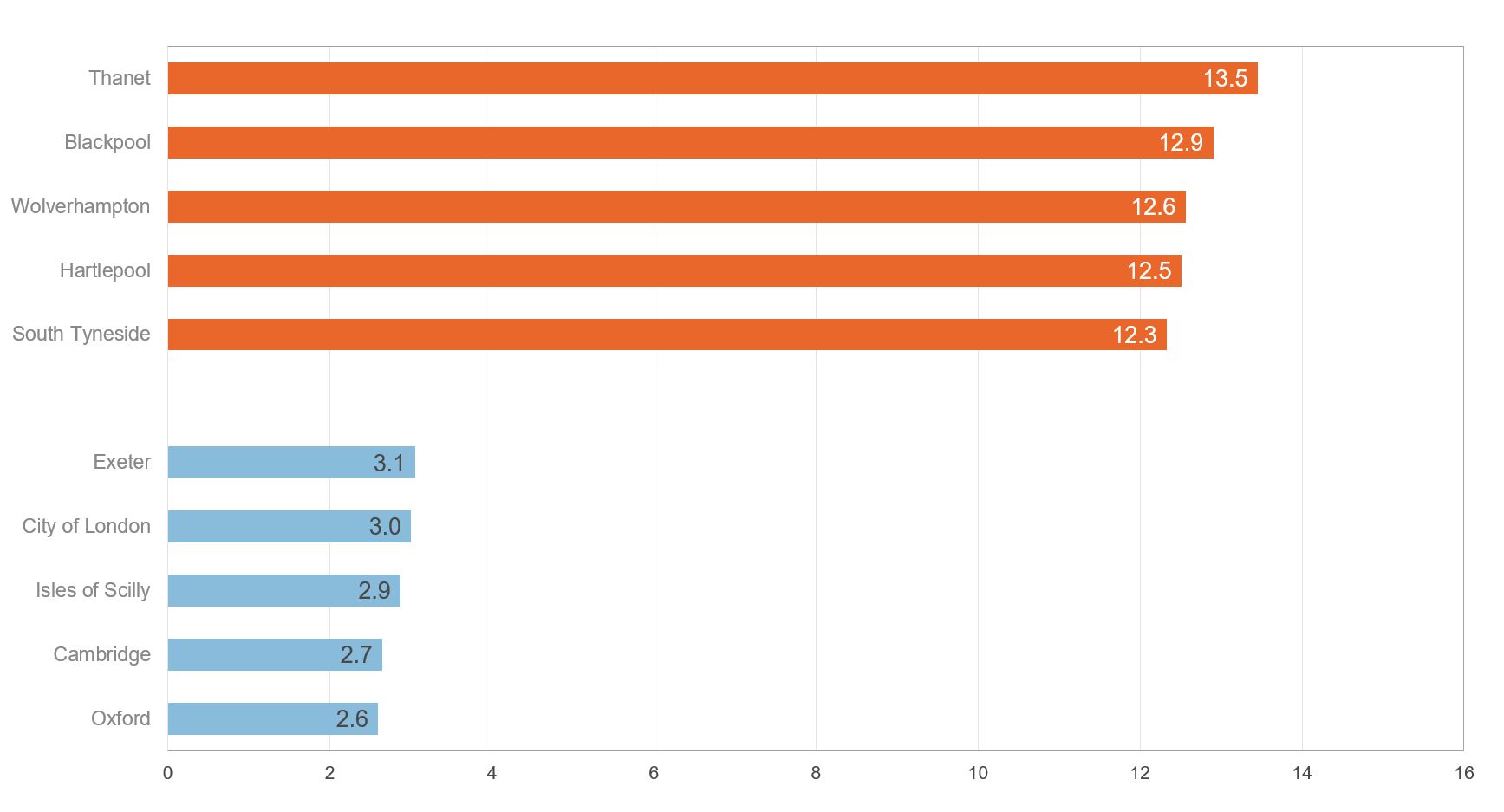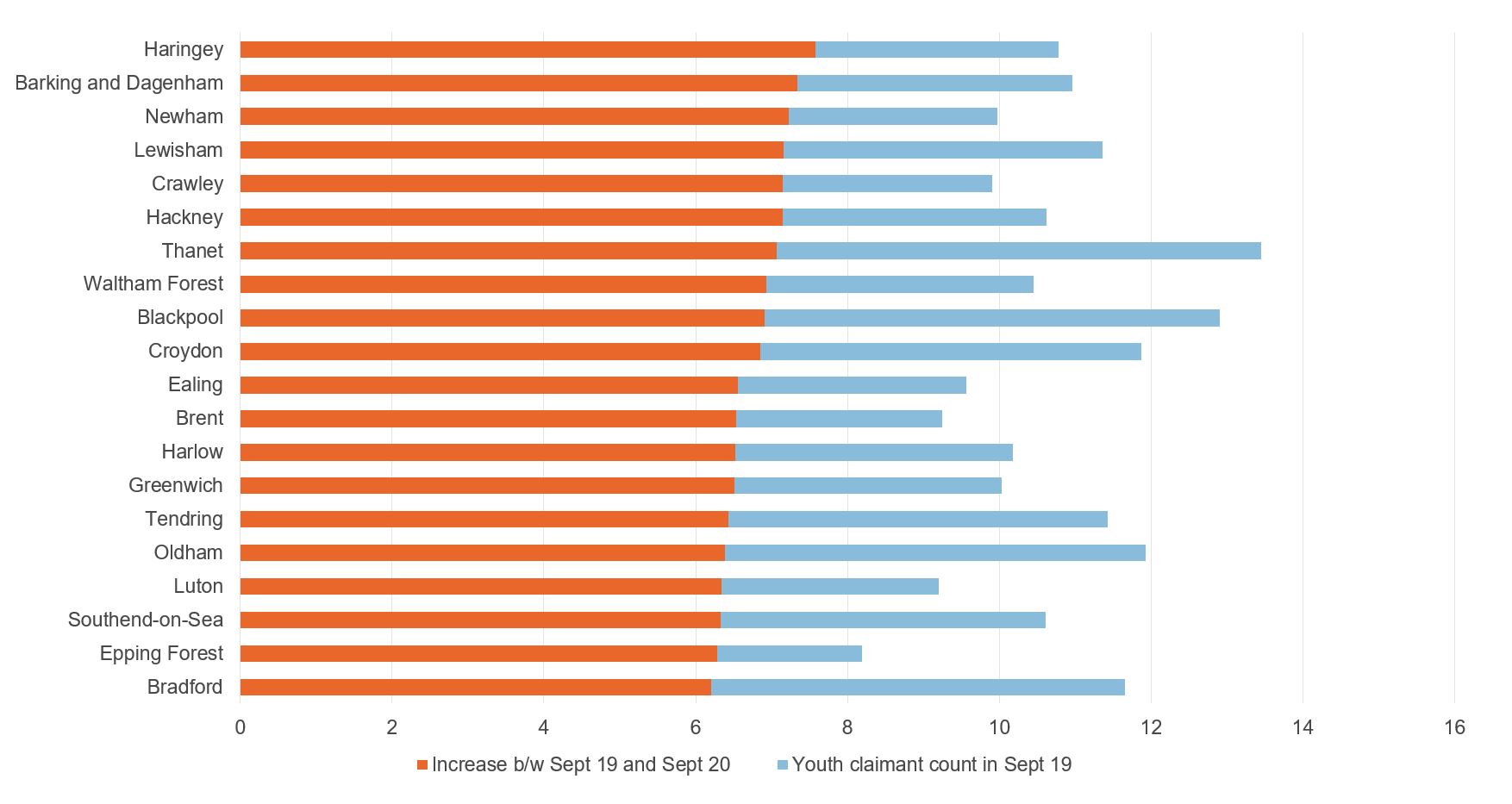The Covid-19 crisis has led to rising youth unemployment and the threat of longer-term ‘scarring’ effects. Policies at the local level can make a difference to young people’s lives by sharing information about support programmes, encouraging take-up and coordinating local networks.
Youth unemployment is increasing across the UK – and this is likely to have long-term impacts on those affected. A period of unemployment when young, especially during a recession, can affect future employment prospects, future wages, future health and future quality of life. These effects are commonly referred to as ‘youth scarring’.
Previous articles on the Economics Observatory have discussed the prospects for young people (Del Bono and Holford, 2020), the long-term effects that Covid-19 will have on their earnings (Xu, 2020) and potential policy responses to youth scarring (Gregg and Tominey, 2020).
Here, we consider the role of local areas in tackling youth scarring. We focus on two ways in which policies at the local level can add value to national approaches: sharing information and encouraging take-up; and coordinating support and planning for the long term.
Why intervene at the local level?
In response to rising youth unemployment, the UK government has introduced a national Kickstart Scheme to provide six-month work placements for those aged 16 to 24 on Universal Credit and at risk of long-term unemployment. Other policy measures have included additional payments of £2,000 for employers in England for each new apprentice aged under 25, expansion of traineeships, and additional funding for Level 2 and 3 qualifications for 18 and 19 year olds.
In broad terms, these reflect the evidence on what works in tackling youth unemployment. An additional local policy response to the national policy response may be important for two reasons.
First, youth unemployment is higher in some local authorities than in others (see Figure 1). For example, in September, the youth claimant count was five times higher in Thanet (13.5%) than in Oxford (2.6%).
Figure 1: Local authority areas with highest and lowest youth claimant count rates, September 2020

Source: Claimant count by sex and age (Nomis) and population estimates (Nomis)
Note: Aged 16-24 years
Youth unemployment has increased in every UK local authority between September 2019 and September 2020, with the increases ranging from 1.8 to 7.6 percentage points (see Figure 2). Of the 20 local authorities with the largest increases in the youth claimant count over this period, 17 are in the Greater South East (London, the South East and the East of England). Many of these areas had relatively low youth unemployment rates prior to Covid-19.
Figure 2: Local authority areas with the largest increase in the youth claimant count rate between September 2019 and September 2020

Source: Claimant count by sex and age (Nomis) and Population Estimates (Nomis)
Note: Aged 16-24 years
The spatial impact of Covid-19 also varies across a wide range of other economic indicators (Magrini and Overman, 2020). Local economies that are more severely affected are likely to find it more difficult to address rising youth unemployment.
The second reason for a local policy response is that many of the networks and structures that support young people operate at the local level. These include education, training, health, housing, and community and voluntary activities. Local policy-makers will have a good understanding of their local economy and the employers, providers and other partners in their area. Interventions that combine evidence on what works with local knowledge and networks should be more effective.
What can local areas do?
Local areas have not been given additional funding specifically to address the challenge of youth unemployment. This means that interventions will need to use existing resources, limiting the scope to intervene. If additional resources become available, we would encourage policy-makers in local areas to follow the evidence – for example, as highlighted in an earlier Economics Observatory article, and in evidence reviews of employment training and of responding to youth unemployment and scarring by the What Works Centre for Local Economic Growth (Gregg and Tominey, 2020; What Works Growth, 2016; What Works Growth, 2020).
The evidence suggests that subsidised employment and training are the most effective interventions to help people get into work (Card et al, 2017). Evidence on two subsidised employment schemes in the UK that specifically targeted young people – the New Deal for Young People and the Future Jobs Fund – found that they increased the amount of time that young people were in unsubsidised employment in subsequent years (Beale et al, 2008; Department for Work and Pensions, 2012).
Even with more limited resources, local areas could still play an important role in at least two ways.
Sharing information and encouraging take-up
With their extensive local knowledge and networks, policy-makers in local areas can help to communicate key messages to residents, businesses and organisations supporting young people.
Given the evidence of the scarring impacts of youth unemployment, young people need to understand the importance of being actively engaged in some form of education, training or employment. Since some groups of young people, such as those with lower educational levels or from ethnic minority groups, are more likely to be affected by youth scarring, it will be particularly important to reach those audiences.
Local areas could help to communicate this message to young people and those who influence them. Evidence shows that receiving information about programme benefits and the application process, as well as assisting applicants, increases take-up. For example, a recent randomised controlled trial in the United States finds that individuals sent information about the benefits and costs of post-secondary education were 40% more likely to enrol (Barr and Turner, 2018).
Similarly, a randomised controlled trial in 2012 showed that students offered both information and assistance in an application process for college financial aid were more likely to submit an application and more likely to attend college than those who received information but no assistance (Bettinger et al, 2012).
Take-up of the Kickstart Scheme, apprenticeships and other programmes is likely to vary across localities. Using networks to promote the scheme to local employers is likely to help to increase take-up.
The Behavioural Insights Team recently published an evidence review of how businesses can be encouraged to take up support (Broughton et al, 2019). While the focus of this study was on business support policies, the lessons are also likely to be relevant for encouraging employers to offer employment and training opportunities to young people. These include simplifying the message and providing clear next steps, reducing frictional costs, leveraging the power of personal and professional networks, and making it timely.
Coordinating support and planning for the longer term
One of the challenges in supporting young people is the wide range of organisations involved. Local areas can help to coordinate services. This could include:
- Linking up services – for example, could existing employability services be used to help prepare young people for available training, apprenticeship and Kickstart opportunities?
- Helping employers participating in the Kickstart Scheme to identify and source good quality job search and training support for recruits.
- Ensuring support is focused on young people with additional barriers, such as disabilities, health issues, low qualifications and/or homelessness.
Policy-makers in local areas should also be planning the medium- to long-term response. The Learning and Work Institute (LWI) highlights the role of annual employment plans designed by local areas and reflecting local needs and national policy goals (Ray et al, 2018).
Other research highlights the value of consulting with local stakeholders and the government (Wilson et al, 2017). Existing structures such as Skills Advisory Panels (SAPs) could perform this role.
As part of this longer-term planning, local areas should also consider whether there are other local policy budgets that could contribute to tackling youth scarring. For example, many local areas have made a commitment to achieving net-zero carbon emissions: the Centre for Economic Performance and the Grantham Research Institute on Climate Change and the Environment have recently published a review of the contribution that different investments in the transition to a zero-emissions, climate-resilient economy can make to jobs and the economy (Unsworth et al, 2020). Perhaps these policies could be used to create additional employment or training opportunities for young people.
Where can I find out more?
- COVID-19: Local responses to youth unemployment and scarring: Summary of the evidence on supporting young people at transition points and on tackling youth unemployment by the What Works Centre for Local Economic Growth. What Works Growth also has toolkits on different aspects of employment training, including careers counselling, financial incentives, pre-employment training and reminders. These provide ‘things to consider’ when designing these support services.
- Securing a place for young people in the nation’s economic recovery: The Youth Employment Group (YEG), led by Impetus, has recommendations for supporting young people at the current time. They also summarise the evidence on Youth Hubs: co-located employment support services for young people.
- Re-thinking youth participation for the present and next generation: education to employment: The Local Government Association (LGA) makes the case for better careers services information at the local level.
Who are experts on this question?
- Paul Gregg, University of Bath
- Tony Wilson, Institute for Employment Studies
- Nicola Aylward, Learning and Work Institute
- Elena Magrini, Centre for Cities
- Sam Windett, Impetus and Youth Employment Group









































